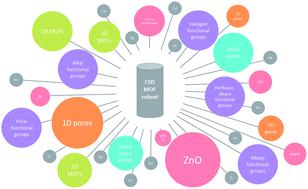当前位置:
X-MOL 学术
›
Chem. Sci.
›
论文详情
Our official English website, www.x-mol.net, welcomes your
feedback! (Note: you will need to create a separate account there.)
Targeted classification of metal–organic frameworks in the Cambridge structural database (CSD)
Chemical Science ( IF 7.6 ) Pub Date : 2020-06-17 , DOI: 10.1039/d0sc01297a Peyman Z. Moghadam 1, 2, 3, 4, 5 , Aurelia Li 1, 2, 3, 4, 5 , Xiao-Wei Liu 1, 2, 3, 4, 5 , Rocio Bueno-Perez 1, 2, 3, 4, 5 , Shu-Dong Wang 6, 7, 8, 9, 10 , Seth B. Wiggin 5, 11, 12 , Peter A. Wood 5, 11, 12 , David Fairen-Jimenez 1, 2, 3, 4, 5
Chemical Science ( IF 7.6 ) Pub Date : 2020-06-17 , DOI: 10.1039/d0sc01297a Peyman Z. Moghadam 1, 2, 3, 4, 5 , Aurelia Li 1, 2, 3, 4, 5 , Xiao-Wei Liu 1, 2, 3, 4, 5 , Rocio Bueno-Perez 1, 2, 3, 4, 5 , Shu-Dong Wang 6, 7, 8, 9, 10 , Seth B. Wiggin 5, 11, 12 , Peter A. Wood 5, 11, 12 , David Fairen-Jimenez 1, 2, 3, 4, 5
Affiliation

|
Large-scale targeted exploration of metal–organic frameworks (MOFs) with characteristics such as specific surface chemistry or metal-cluster family has not been investigated so far. These definitions are particularly important because they can define the way MOFs interact with specific molecules (e.g. their hydrophilic/phobic character) or their physicochemical stability. We report here the development of algorithms to break down the overarching family of MOFs into a number of subgroups according to some of their key chemical and physical features. Available within the Cambridge Crystallographic Data Centre's (CCDC) software, we introduce new approaches to allow researchers to browse and efficiently look for targeted MOF families based on some of the most well-known secondary building units. We then classify them in terms of their crystalline properties: metal-cluster, network and pore dimensionality, surface chemistry (i.e. functional groups) and chirality. This dynamic database and family of algorithms allow experimentalists and computational users to benefit from the developed criteria to look for specific classes of MOFs but also enable users – and encourage them – to develop additional MOF queries based on desired chemistries. These tools are backed-up by an interactive web-based data explorer containing all the data obtained. We also demonstrate the usefulness of these tools with a high-throughput screening for hydrogen storage at room temperature. This toolbox, integrated in the CCDC software, will guide future exploration of MOFs and similar materials, as well as their design and development for an ever-increasing range of potential applications.
中文翻译:

剑桥结构数据库(CSD)中金属有机框架的目标分类
到目前为止,尚未针对具有特定表面化学性质或金属簇族等特征的金属有机骨架(MOF)进行大规模的定向勘探。这些定义特别重要,因为它们可以定义MOF与特定分子相互作用的方式(例如它们的亲水/疏水特性)或理化稳定性。我们在这里报告算法的发展,以根据MOF的一些关键化学和物理特征将其划分为多个子组。在剑桥晶体数据中心(CCDC)软件中可用,我们引入了新方法,使研究人员可以基于一些最著名的二级建筑单位浏览并有效地寻找目标MOF系列。然后,我们根据其晶体性质对它们进行分类:金属簇,网络和孔尺寸,表面化学(即官能团)和手性。这种动态数据库和算法系列使实验人员和计算用户可以从已开发的标准中受益,以查找特定类别的MOF,同时还可以使用户(并鼓励他们)根据所需化学物开发其他MOF查询。这些工具由包含所有获得的数据的基于Web的交互式数据浏览器备份。我们还通过在室温下对氢存储进行高通量筛选来证明这些工具的有用性。该工具箱已集成在CCDC软件中,将指导MOF和类似材料的未来探索,以及它们对不断增长的潜在应用范围的设计和开发。
更新日期:2020-08-20
中文翻译:

剑桥结构数据库(CSD)中金属有机框架的目标分类
到目前为止,尚未针对具有特定表面化学性质或金属簇族等特征的金属有机骨架(MOF)进行大规模的定向勘探。这些定义特别重要,因为它们可以定义MOF与特定分子相互作用的方式(例如它们的亲水/疏水特性)或理化稳定性。我们在这里报告算法的发展,以根据MOF的一些关键化学和物理特征将其划分为多个子组。在剑桥晶体数据中心(CCDC)软件中可用,我们引入了新方法,使研究人员可以基于一些最著名的二级建筑单位浏览并有效地寻找目标MOF系列。然后,我们根据其晶体性质对它们进行分类:金属簇,网络和孔尺寸,表面化学(即官能团)和手性。这种动态数据库和算法系列使实验人员和计算用户可以从已开发的标准中受益,以查找特定类别的MOF,同时还可以使用户(并鼓励他们)根据所需化学物开发其他MOF查询。这些工具由包含所有获得的数据的基于Web的交互式数据浏览器备份。我们还通过在室温下对氢存储进行高通量筛选来证明这些工具的有用性。该工具箱已集成在CCDC软件中,将指导MOF和类似材料的未来探索,以及它们对不断增长的潜在应用范围的设计和开发。











































 京公网安备 11010802027423号
京公网安备 11010802027423号